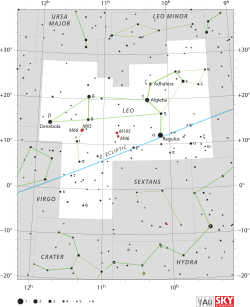Delta Leonis

Location of δ Leonis (circled) | |
| Observation data Epoch J2000 Equinox J2000 | |
|---|---|
| Constellation | Leo |
| Right ascension | 11h 14m 06.50142s[1] |
| Declination | 20° 31′ 25.3853″[1] |
| Apparent magnitude (V) | 2.56[2] |
| Characteristics | |
| Spectral type | A4 V[3] |
| U−B color index | +0.12[4] |
| B−V color index | +0.12[4] |
| Variable type | Delta Scuti |
| Astrometry | |
| Radial velocity (Rv) | -20.2[2] km/s |
| Proper motion (μ) | RA: +143.42[1] mas/yr Dec.: -129.88[1] mas/yr |
| Parallax (π) | 55.82 ± 0.25[1] mas |
| Distance | 58.4 ± 0.3 ly (17.91 ± 0.08 pc) |
| Details | |
| Mass | 2.2[5] M☉ |
| Radius | 2.14 ± 0.040[6] R☉ |
| Luminosity | 15.5 ± 1.8[6] L☉ |
| Surface gravity (log g) | 3.91[7] cgs |
| Temperature | 8,296[6] K |
| Rotational velocity (v sin i) | 180[8] km/s |
| Age | 0.60-0.75[5] Gyr |
| Other designations | |
| Database references | |
| SIMBAD | data |
Delta Leonis (δ Leo, δ Leonis) is a star in the zodiac constellation of Leo. It has the traditional names Zosma (or Zozma) and Duhr. Rare spellings include Zozca, Zosca, Zubra, and Dhur. The name Zosma means girdle in ancient Greek, referring to the star's location in its constellation, on the hip of the lion.[9] Based upon parallax measurements, it lies at a distance of about 58.4 light-years (17.9 parsecs) from the Earth.[1]
Properties
Zosma is a relatively ordinary main sequence star with a stellar classification of A4 V,[3] making it is somewhat larger and hotter than the Sun. It is a fairly well-studied star, allowing relatively accurate measurements of its age and size. The radius of the star, as measured directly using an interferometer, is about 214% of the Sun's radius and it is emitting more than 15 times as much luminosity as the Sun. The energy is being emitted from the outer envelope with an effective temperature 8,296 K,[6] giving it the white hue characteristic of an A-type star. Having a larger mass than the Sun it will have a shorter lifespan, and in another 600 million years or so will swell into an orange or red giant star before decaying quietly into a white dwarf.[5]
This star is rotating rapidly, with a projected rotational velocity of 180 km s−1. The inclination of the axis of rotation to the line of sight from the Earth is estimated at 38.1°, which would mean the azimuthal velocity along the equator is about 280 180 km s−1. This rotation is producing an equatorial bulge, giving the star a pronounced oblate spheroidal shape. The polar radius is about 84% of the radius along the equator.[8]
Based upon the location and trajectory of this star through space, it may be a member of the Ursa Major Moving Group, a type of stellar kinematics group that share a common origin and motion through space.[11] The age of this group is about 500 million years.[12]
See also
- List of stars in Leo
- Class A Stars
- Delta Scuti Variable Stars
References
- ↑ 1.0 1.1 1.2 1.3 1.4 1.5 van Leeuwen, F. (November 2007), "Validation of the new Hipparcos reduction", Astronomy and Astrophysics 474 (2): 653–664, arXiv:0708.1752, Bibcode:2007A&A...474..653V, doi:10.1051/0004-6361:20078357
- ↑ 2.0 2.1 Wielen, R. et al. (1999), Sixth Catalogue of Fundamental Stars (FK6). Part I. Basic fundamental stars with direct solutions (35), Astronomisches Rechen-Institut Heidelberg, Bibcode:1999VeARI..35....1W
- ↑ 3.0 3.1 Cowley, A. et al. (April 1969), "A study of the bright A stars. I. A catalogue of spectral classifications", Astronomical Journal 74: 375–406, Bibcode:1969AJ.....74..375C, doi:10.1086/110819
- ↑ 4.0 4.1 Johnson, H. L. et al. (1966), "UBVRIJKL photometry of the bright stars", Communications of the Lunar and Planetary Laboratory 4 (99), Bibcode:1966CoLPL...4...99J
- ↑ 5.0 5.1 5.2 Kaler, James B., ZOSMA (Delta Leonis), University of Illinois, retrieved 2010-05-12
- ↑ 6.0 6.1 6.2 6.3 Akeson, R. L. et al. (February 2009), "Dust in the inner regions of debris disks around a stars", The Astrophysical Journal 691 (2): 1896–1908, arXiv:0810.3701, Bibcode:2009ApJ...691.1896A, doi:10.1088/0004-637X/691/2/1896
- ↑ Malagnini, M. L.; Morossi, C. (November 1990), "Accurate absolute luminosities, effective temperatures, radii, masses and surface gravities for a selected sample of field stars", Astronomy and Astrophysics Supplement Series 85 (3): 1015–1019, Bibcode:1990A&AS...85.1015M
- ↑ 8.0 8.1 Royer, F. et al. (2002), "Rotational velocities of A-type stars in the northern hemisphere. II. Measurement of v sin i in the northern hemisphere", Astronomy and Astrophysics 393 (3): 897–911, arXiv:astro-ph/0205255, Bibcode:2002A&A...393..897R, doi:10.1051/0004-6361:20020943
- ↑ 9.0 9.1 Allen, Richard Hinckley (1899), Star-names and their meanings, G. E. Stechert, p. 260
- ↑ "del Leo -- Variable Star", SIMBAD (Centre de Données astronomiques de Strasbourg), retrieved 2010-05-12
- ↑ Nakajima, Tadashi; Morino, Jun-Ichi; Fukagawa, Misato (September 2010), "Potential Members of Stellar Kinematical Groups within 20 pc of the Sun", The Astronomical Journal 140 (3): 713–722, Bibcode:2010AJ....140..713N, doi:10.1088/0004-6256/140/3/713
- ↑ King, Jeremy R. et al. (April 2003), "Stellar Kinematic Groups. II. A Reexamination of the Membership, Activity, and Age of the Ursa Major Group", The Astronomical Journal 125 (4): 1980–2017, Bibcode:2003AJ....125.1980K, doi:10.1086/368241
| ||||||||||||||||||||||||||